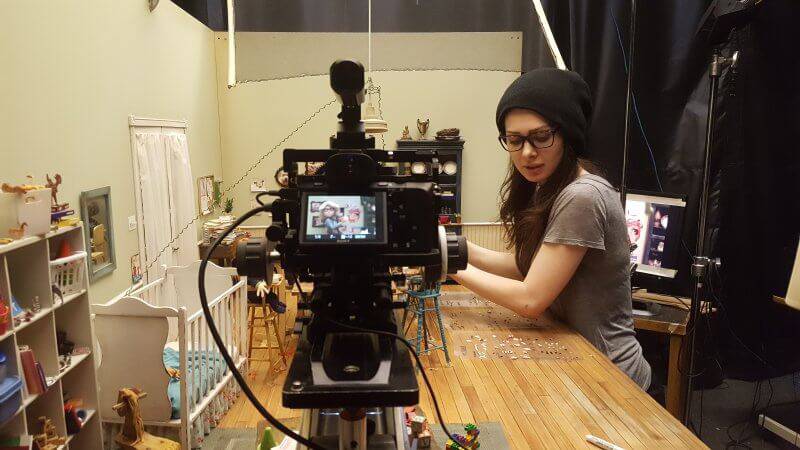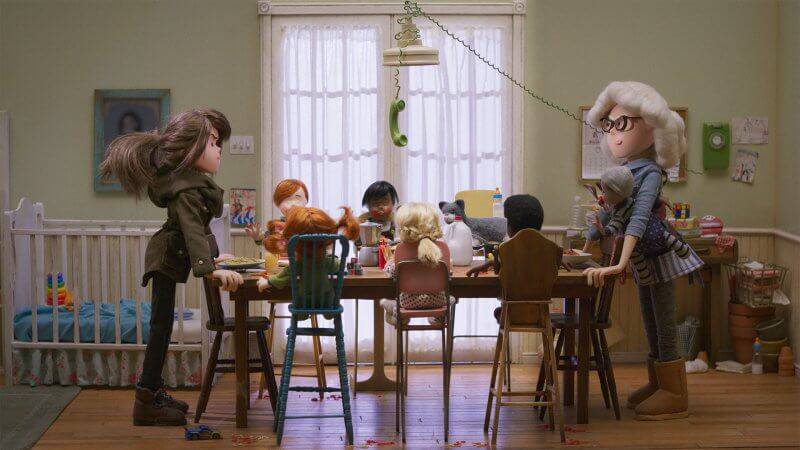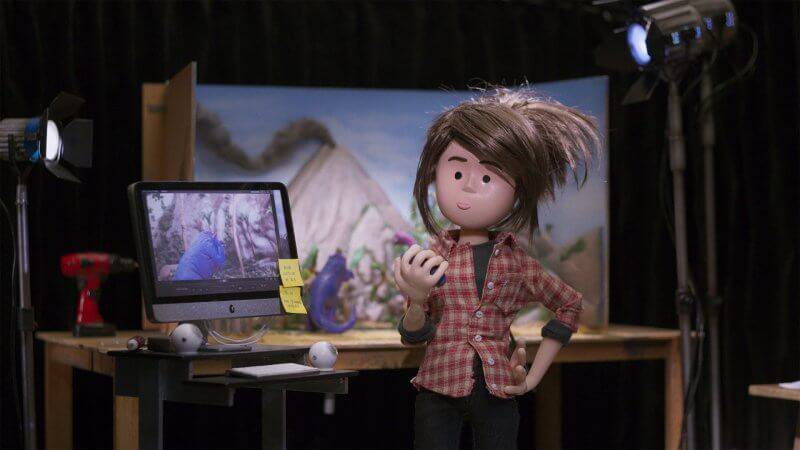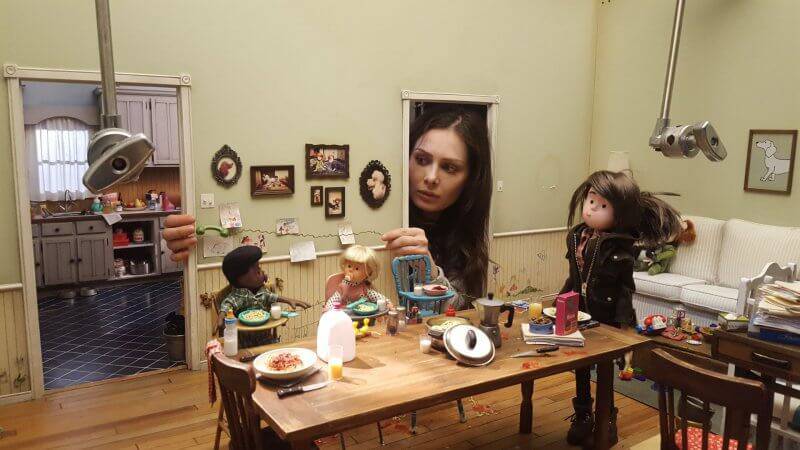Q&A with ‘Freaks of Nurture’ director Alexandra Lemay
Today on Skwigly we meet Montreal based artist and stop-motion animator Alexandra Lemay. Having studied at Concordia University and Sheridan College, Alexandra’s experience in the arts industry spans independent filmmaking, animation, practical special effects and puppet and costume fabrication. Having been selected for the tenth edition of the National Film Board of Canada‘s Hothouse apprenticeship scheme in 2014, her micro-short All the Rage proved to live up to its title, with selections at prominent international festivals including Ottawa International Animation Festival and Sommets du cinéma d’animation. Recently Alexandra has completed her latest NFB short Freaks of Nurture, a quasi-autobiographical story of a young animator’s relationship with her mother and the charmingly-observed juxtaposition of how each deal with their respective stresses in life. Having premiered earlier this year at the Palm Springs International ShortFest, Freak of Nurture will screen this weekend at the 14th Annual NYC Short Film Festival. We caught up with Alexandra to learn more about her new work and evolving relationship with the NFB.

Alexandra Lemay (Photo: Stephan Ballard)
Can you tell us a bit about your background and path to animation prior to your involvement with the NFB?
I studied animation at Concordia University, and in my last year, I took an “Introduction to Stop-Motion” course. The teacher was Montreal Stop-Motion Festival founder and armaturist extraordinaire, Erik Goulet. Needless to say, he got me hooked. My graduating project was a stop-motion film, and making it made me realize how much I still had to learn about the craft. I decided to go do a post-graduate certificate at Sheridan College in Advanced Special Effects, Props and Prosthetics in an attempt to learn the ins and outs of stop-motion puppet-making. Upon graduation, I worked mostly in large-scale fabrication jobs; making monster suits, mascot costumes and, of course, dinosaurs. I loved creature-making, but I definitely missed the storytelling that animation brought to the table. It wasn’t until I applied to the NFB’s Hothouse apprenticeship program that I made my first (non-student) film and rekindled my obsession with miniatures and stop-motion.
When we first spoke you had recently concluded your involvement with the NFB’s Hothouse scheme having produced the film All The Rage. How has this experience and the film’s subsequent performance contributed to your career direction so far?
All the Rage had unexpected success; it played in a handful of festivals and was even nominated for the best animated short award at the Gala Québec Cinéma. That was obviously fantastic news (and definitely surprising), but I was already well on my way to making my next film with the NFB by then. I actually wrote my Freaks of Nurture proposal during Hothouse. I fell in love with the NFB, hard, and it became a mission to make another film with them as soon as possible. I pitched my idea to my Hothouse Associate Producer, John Montes, and he gave me the courage to officially propose it to my producer, Maral Mohammadian. It took a long time to get it officially produced, so I continued working for museum exhibits and taking freelance animation gigs in the meantime. I worked on some cool projects, but everything between those two films was pretty much bread-and-butter survival gigs.
As a relatively new face in the industry, how do you find the animation scene/community of Montreal in terms of support/being conducive to creativity?
When I was working on Freaks, I had just moved back to Montreal and all my contacts were in Toronto, so it was tough. I had trouble being taken seriously at first, just as I did when I started in Toronto, but I think that’s true for most people new to the game. Now that I’ve been back in MTL a few years, I’ve discovered that there is a pretty solid stop-motion community here and a lot of support for my work and that of other women in the industry. The jobs are still limited, but if you hunt for them you can find them. I think stop-motion work will always be challenging to find, wherever you are in the world.

Making Freaks of Nurture (Photo ©Luka Sanader)
What were the production circumstances that allowed this film to get off the ground?
Maral Mohammadian was my producer on Hothouse, and I really wanted to work with her again. After sending my proposal to the NFB, I didn’t hear back from her and assumed the project was dead. Months later, I found out we would both be in Annecy at the same time. We ended up meeting up, and I unloaded this crazy rant about my mom and I saw her eyes light up. I think that was the first time she understood what I was trying to do with Freaks of Nurture, and the wheels started turning. After that, I was able to get a contract to write the first of many script drafts. I was constantly fighting my apprehensions about the personal subject matter. It was hard to be honest about confronting my hang-ups about my mother and our unusual lifestyle growing up. It took time to find the tone and story that felt right.
What were some of your primary influences for the puppet design of the film (and to what extent were you directly involved in the art direction)?
I was the art director on the project, and it was important that the look felt nostalgic and funny. I wanted the puppets to be cartoons living in these hyper-realistic sets to touch on the fact that these characters were caricatures of real people. I wanted to avoid putting them in equally stylized sets because it would have taken away the credibility that realistic environments bring. These goofy characters moving around in a space that feels so familiar makes them feel somewhat more real and consequently relatable. Rankin/Bass films also inspired the character design, mainly because it reminds me of my childhood. The mother’s house was based on my mom’s actual house and I even acquired the blueprints. In retrospect, it wasn’t the best way to design a stop-motion set due to the limited accessibility, but I made it work (even if often stuck halfway in a miniature doorway, praying I wouldn’t fall over and break it to pieces). I wanted to have an eclectic mix of props to make the spaces feel lived in. For the mom’s environment, I wanted mismatched chairs and a mix of toys from different eras to sell the hand-me-down/thrift store vibe that growing up in a big family brings. For the daughter’s studio, I really wanted to have tools and materials I’ve used as a fabricator and animator lying around; smooth cast products, dragon frame, you name it, it’s there.

Freaks of Nurture (Dir. Alexandra Lemay)
What sort of fabrication process did you use for the puppets?
Once I designed the characters, Erik Goulet built the armatures and rigs. Then, I sculpted the characters and made the clothing. The puppets were sculpted out of clay, then molded and casted out of various materials (foam latex for the bodies, silicone for the limbs and plastic for the heads). I wanted a design that allowed improvisation in the animation. I sculpted about four heads for each adult with extreme expressions (neutral, angry, worried, confused) but no facial features. Then I sculpted and cast a variety of facial features (eyes, eyebrows, lips) separately and glued them on with Vaseline (a tip I learned while working on a contract for Cuppa Coffee, a Toronto-based animation studio). I made the clothing by modifying doll patterns and finding fabrics with tiny designs that worked with the scale I was working with. The animals were needle-felted.
What were some of the main differences between the experience of creating Freaks of Nurture and your previous film?
This was the first time I had to direct a team as opposed to doing everything myself. With All the Rage, I had the NFB team by my side, but it was more of a mentorship situation rather than an official crew. For Freaks of Nurture, I had the pleasure of working with the uber-talented Jako Lanterne, a Montreal-based fabrication studio. They built the props and sets of the film and they did an amazing job! This was the first time I had to direct fabricators and it was a trip. I also had mold-makers help with molding and casting. Another first was working with DOP Luka Sanader, which was equal parts amazing and frustrating. It was strange at first because I like to work alone, and it felt like I was sharing a very intimate space. Working so closely to him did ultimately make me appreciate his craft and recognize my limited knowledge of cinematographic gear. I feel very privileged to have worked with such a talented team.

Freaks of Nurture (Dir. Alexandra Lemay)
The animation-within-the-animation sequences were a great touch, did the scale of these present any challenges?
I actually built large-scale and miniature versions of the dinosaurs. The dinosaur set is the only set I built because I really wanted it to have a DIY feel and, well, Jako Lanterne is just too good! Once I realized how much of a camera nerd Luka was, I figured I should attempt to shoot the dinosaurs on film, and of course he had the camera and film ready to go as soon as I suggested it. I was already giving homage to Ray Harryhausen, so it just felt appropriate to shoot those scenes on film. It was obviously super-challenging, but totally worth it in the end. It makes me appreciate the legends of stop-motion that much more!
What were some of the autobiographical elements for this film, and what made you decide to draw on them for the story?
Reality is stranger than fiction in this case, because my mom actually has more children and animals than in the film. I truly don’t know how many dogs she has now but it’s definitely an unreasonable amount. I stayed at my mom’s house while making All the Rage and that’s what inspired me to make Freaks of Nurture. I was living in Toronto at the time and got this three-month contract with the NFB in Montreal, so I figured, “Why not stay at my mom’s house rent-free”? Well, needless to say, it was an experience that uncovered a bunch of emotions I didn’t know I had. I suddenly felt like a self-centred angsty teen who had a bone to pick with my mom. My family inspired the film, but it’s really meant to be a slice of life relatable to anyone. I didn’t want to just make a film about crazy stuff happening, I wanted room to have complicated emotions even if camouflaged in goofy chaos. That’s when I realized I had to dance around reality, humour, emotions and honesty and try to find a balance within the can of worms I had just opened. What has your family’s response to the film been? My mom had the best response: “It works because it’s so exaggerated,” which is hilarious and fitting. I genuinely think she finds comfort in her chaos and truly doesn’t grasp how crazy her lifestyle is. That or she’s playing the part; I’m still not sure which is truer. All jokes aside, she’s been super-supportive about the whole thing, which is great considering she never chose to be in this. As for my siblings, they love it.
Did growing up in that environment have a discernible impact on the work you do today?
I definitely think the environments we grow up in affect who we become on some level. I’m an introvert at heart and yet over-share details of my personal life on a regular basis. I don’t like chaos but I thrive in it. What I do for a living is proof of that, and I’m sure my upbringing built that in me somewhat.

Making Freaks of Nurture (Photo ©Luka Sanader)
Do you have any in-progress/upcoming projects you are able to talk about?
I’ve started writing a new proposal for my next project, which is inspired by my sister. It’s weirder and darker, but just as personal. I’m a little scared, but also really excited about it. I also plan on making short animations just for fun to keep me inspired between bigger projects.
Freaks of Nurture screens at the 14th Annual NYC Short Film Festival on October 20th and 21st.
For more on the work of Alexandra Lemay visit alexandralemay.tumblr.com

